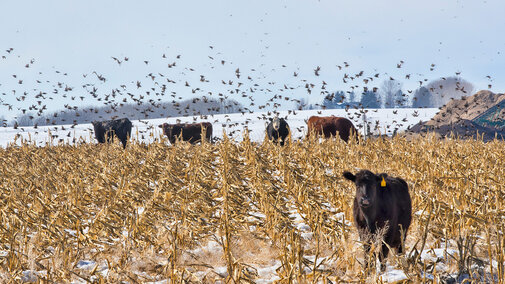Mid-winter Cornstalk Grazing
Here in mid-winter, cornstalks remain a great forage resource for livestock producers. Snow cover on cornstalks is generally not a problem for cattle as they are adept at digging their way through to get at the leaves, husks and remaining corn that they are seeking. However, if an icy crust develops on the snow, this will limit grazing and supplemental feed may need to be provided.
Another important consideration is the stocking rate and how long they have been in a particular field. Nutritional value of cornstalk residue is greatest at the beginning of a grazing period and declines with time as the most nutritious plant parts are consumed. A general stalk grazing rule is there is about 30 cow days per 100 bushels of corn that the field produced.
Over the fall and winter, weathering can also play a role in reducing cornstalk quality. Rain or melting snow soaks into dry cornstalk residue and leaches out some of the soluble nutrients. Most serious is the loss of sugars and other energy-dense nutrients, which lowers the TDN or energy value of the stalks.
Another factor that affects cornstalk grazing is wind. We have had our share of excessively high winds, which easily blow corn leaves and husks off the field. This, of course, can impact the amount of feed, and after grain, those leaves and husks contain the highest nutritional quality.
Cornstalks are still a great and economical winter feed source. Just be sure to closely monitor cow and field conditions while adjusting your supplementation program accordingly.
Pasture Lease Drought Considerations
Drought conditions usually occur one out of every five years in Nebraska especially in the western regions. Further, when severe drought conditions occur in one year, the majority of the time, another extreme drought subsequentially follows in the next growing season. Our last back-to-back extreme drought occurred in 2012 and 2013. Will the extreme 2022 drought conditions repeat again this year? If so, should pasture lease agreements be adjusted?
Historically, pastures (especially in the western region) need time for full recovery after drought. During Dust Bowl years, heavily (overgrazed) pastures often resulted in delayed forage production for up to five years, whereas moderately grazed pastures recovered quicker.
So, now may be the time for landowners and tenants to include a clause in their written pasture lease agreements to account for potential dry conditions. Other pasture biomass management clauses might include severe hail and wildfire considerations.
Traditionally, pasture leases are for five or six months from April or May through October. Previously, stressed warm-season grass pastures might be rested by delaying grazing season start in 2023. Further, pasture stocking rates could be reduced 10-15% and adjusted further if drought continues. In fairness, pasture rent owed should also be adjusted accordingly if the grazing season is shortened.
Consider pricing leases based on grazing animal unit months (AUM’s) rather than a flat rate per acre or cow-calf pair. A clause might be added to cover livestock water in case water source go dry. Typically, pasture weed control is a landlord expense, but if the pasture was overgrazed due to drought, weed control costs might be shared between landowners and tenants.
Start your communications early and make written agreements for fairness and equity. UNL Extension Ag Econ provides free fillable AgLease101.org leases at the Center for Ag Profitability. Other drought information is available online at UNL Beef and CropWatch.

